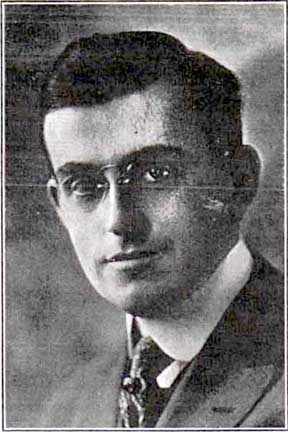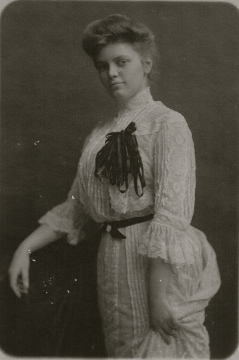Harvey
S[taring] Horton in Buffalo, NY
|
Harvey
Staring Horton, Architect
By Jennifer Walkowski An excerpt from the Huyler’s Candy Company Nomination for Listing on the State & National Registers of Historic Places. Prepared by Clinton Brown Company Architecture/Rebuild  Horton was born in Silver Creek, NY, located about 35 miles south of Buffalo, on April 25, 1884 to Charles C. and Leora (née Staring). His father Charles C. worked as a fruit grower in Silver Creek, which is located in the heart of a fertile agricultural area along Lake Erie. Horton was educated in the local grammar and high schools in Silver Creek before he attended Cornell University. While at Cornell, Horton was awarded the Clifton Beckwith Brown Bronze Medal from the school for his high grades in architectural design achieved throughout the course of his studies. After graduating from the prestigious school with a Bachelor of Architecture degree in 1906, Horton worked with the prominent New York City-based architectural firm of Carrère and Hastings. Carrère and Hastings are significant locally in Western New York for John M. Carrére’s role as Chairman of the Pan-American Exposition Board of Architects and for the firm’s design of the McKinley Monument in Niagara Square, designed in 1907 to commemorate President McKinley’s asassination at the Exposition in 1901. Eventually Horton worked with important Buffalo architect, George Cary. These experiences would have given Horton a solid background in the Beaux Arts stylistic school of architecture and design, which focused on technical skills such as drawing and painting, and also on the fundamentals of “good” architecture such as form, proportion, and aesthetics that drew largely from classical models of Roman and Greek antiquity. This experience would have been further augmented when he took a six month trip spent traveling through Europe, no doubt studying the art and architecture of the continent which was heavily influenced by Classical styles at the time. On October 26, 1913, Horton married Mildred Abell of Buffalo. After working with Cary, Horton established his own practice in 1916 in an office located in the Marine National Bank Building on Main Street (contributing to the NPS-certified local Joseph Ellicott Historic District). Eventually, Horton relocated to the prestigious Prudential Building with an office at 1318 (also known as the Guaranty Building, NHL 1975). Noted among the works of Harvey S. Horton are the English Tudor style Saddle and Bridle Club of Buffalo, located on Amherst Street (1922, NRE).[1] Horton also designed the Collegiate Gothic style Methodist Episcopal Church (ca. 1920s, NRE) and the Gothic Revival style Silver Creek High School (1923, NRE), both located on South Main Street in his native Silver Creek, NY. Several Marine bank (now HSBC bank) branches were also said to have been designed by Horton. He also designed the Lancaster Memorial Building, in Lancaster, NY (currently unidentified building). Besides his design for the Huyler Building of 1923-1925, records indicate Horton also designed or renovated another Huyler’s building in Buffalo as well. Besides his larger commissions, Horton also designed several residential projects. While many are unidentified at this time, one of the most prominent examples of his residential work is the William H. Bayliss House, also known as the Bayliss-Oishei House (NRE). Located at 360 Depew Avenue, this stunning example of Tudor Revival architecture was designed by Horton in 1935. The house was home to prominent businessman William Bayliss until his death in 1951, and following the death of his wife in 1954, the house was purchased by daughter Mary Elizabeth and her husband, Robert Chittenden Oishei. Oishei was also a prominent businessman in Buffalo, founding Fibron Products which manufactured a laminated wood used for cutlery and industrial uses. Recently, the house has served as the Junior League of Buffalo’s Decorator’s Show House of 2011.[2] Like many contemporary architects, Horton was also involved in local groups and organizations and his clients indicate membership in high society. Harvey S. Horton was a member of the Buffalo Athletic Club, the University Club and the Cornell Club. Horton was a member of the First Presbyterian Church in Buffalo and was active in the congregation. He was also very involved locally in architectural organizations. He was noted as serving as Director of the Buffalo Association of Architects, and also served as treasurer and president of the Buffalo Chapter of the American Institute of Architects (AIA) in the 1920s. He was active in the local architectural scene as well, as he was one of a group of architects who fought to preserve the facade of the Albright-Knox Art Gallery (1890-1905, E.B. Green, NR 1971) when a new addition was constructed in 1962, making Horton perhaps one of Buffalo’s early preservationists. Harvey Staring Horton continued his practice for many years until retiring after 48 years around 1964. After residing in Miami, Florida with his sister for a few months following his retirement, Horton passed away at the age of 83 on October 4, 1965 and was later interred in Buffalo’s Forest Lawn Cemetery (1849, NR 1990).[3] [1] J.N. Kins, "The Accomplishment of Forty Years," The National Magazine XLI (Oct 1914 - Mar 1915, Inclusive): 536-40. [2] J.N. Kins, "The Accomplishment of Forty Years," The National Magazine XLI (Oct 1914 - Mar 1915, Inclusive): 536-40. [3] "John S. Huyler Dies in 65th Year." The New York Times 2 Oct. 1910: 13. |

